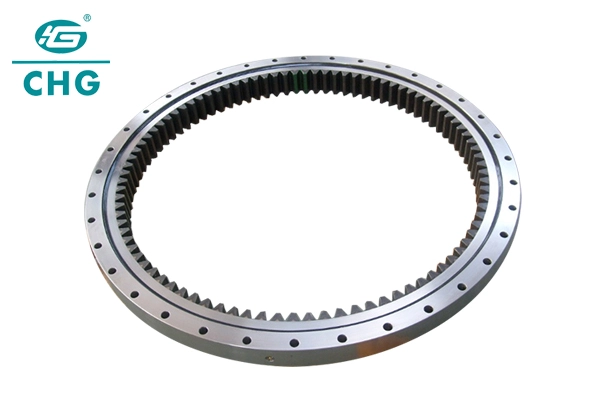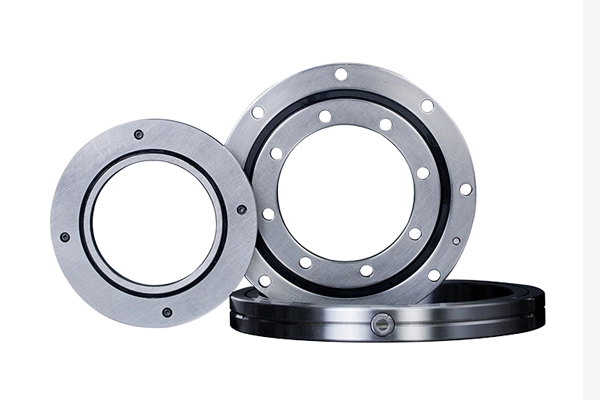What is the Lifespan of Crossed Cylindrical Roller Slewing Bearings?
Understanding the lifespan of Crossed Cylindrical Roller Slewing Bearings is crucial for engineers, maintenance professionals, and industry stakeholders who rely on these essential components in various applications. These sophisticated bearings play a vital role in heavy machinery and equipment, making their longevity a critical factor in operational planning and maintenance schedules. This comprehensive guide explores the factors affecting bearing lifespan, maintenance practices, and optimization strategies to ensure maximum service life.

How Do Operating Conditions Impact the Service Life of Crossed Cylindrical Roller Slewing Bearings?
Environmental Factors and Their Effects
The lifespan of Crossed Cylindrical Roller Slewing Bearings is significantly influenced by the environmental conditions in which they operate. In industrial settings, these bearings often face challenges such as exposure to dust, moisture, and temperature variations. When operating in harsh environments, Crossed Cylindrical Roller Slewing Bearings require specialized sealing solutions and appropriate lubrication systems to maintain their integrity. The presence of contaminants can accelerate wear patterns and reduce the expected service life by up to 40%. Therefore, implementing proper protection measures, including advanced sealing technologies and regular environmental monitoring, becomes essential for maintaining optimal bearing performance and extending their operational lifespan.
Load Distribution Patterns
Understanding load distribution is fundamental to predicting and optimizing the lifespan of Crossed Cylindrical Roller Slewing Bearings. These bearings are designed to handle both axial and radial loads simultaneously, making them ideal for applications requiring multi-directional support. The distribution of loads across the bearing surface directly impacts wear patterns and fatigue life. When properly aligned and loaded within their designed specifications, Crossed Cylindrical Roller Slewing Bearings can maintain their structural integrity for extended periods. However, uneven load distribution or excessive loading can lead to premature failure and reduced service life. Regular monitoring of load patterns and implementing appropriate load management strategies can significantly extend the bearing's operational lifespan.
Speed and Rotation Considerations
The operational speed and rotation patterns of Crossed Cylindrical Roller Slewing Bearings play a crucial role in determining their service life. These bearings are typically designed for moderate to low-speed applications, but the actual speed requirements can vary based on specific applications. Higher speeds generate more heat and require more sophisticated lubrication systems to maintain proper functioning. The relationship between speed, temperature, and lubrication must be carefully balanced to optimize bearing performance. Additionally, intermittent operation versus continuous rotation can affect wear patterns and maintenance requirements differently. Understanding these dynamics helps in implementing appropriate speed control measures and maintenance protocols.

What Maintenance Practices Are Essential for Maximizing Crossed Cylindrical Roller Slewing Bearing Life?
Lubrication Management Strategies
Proper lubrication is perhaps the most critical aspect of maintaining Crossed Cylindrical Roller Slewing Bearings. The right lubrication strategy involves selecting appropriate lubricants, establishing optimal relubrication intervals, and implementing effective delivery systems. Modern Crossed Cylindrical Roller Slewing Bearings often require specialized lubricants that can withstand high pressures and maintain their properties under varying operating conditions. Regular lubrication analysis and monitoring help identify potential issues before they lead to bearing damage. The implementation of automated lubrication systems can ensure consistent and appropriate lubricant delivery, reducing the risk of under- or over-lubrication, both of which can significantly impact bearing lifespan.
Inspection and Monitoring Protocols
Regular inspection and monitoring are essential for maintaining the health of Crossed Cylindrical Roller Slewing Bearings. This includes visual inspections, vibration analysis, and temperature monitoring. Advanced monitoring techniques, such as ultrasonic testing and oil analysis, can provide early warning signs of potential bearing problems. Establishing a comprehensive inspection schedule that includes both routine checks and detailed examinations helps identify wear patterns, misalignment issues, or contamination problems before they become critical. The data collected through these monitoring activities should be carefully documented and analyzed to track bearing performance over time and predict potential maintenance needs.

Alignment and Installation Procedures
Proper alignment and installation procedures are fundamental to achieving optimal performance and longevity of Crossed Cylindrical Roller Slewing Bearings. The installation process must follow manufacturer specifications precisely, including proper mounting procedures, torque settings, and alignment checks. Even minor misalignment can lead to uneven load distribution and accelerated wear. Regular alignment checks and adjustments throughout the bearing's service life ensure continued optimal performance. The use of precision alignment tools and techniques, combined with proper documentation of installation and maintenance procedures, helps maintain bearing integrity and extend service life.
What Factors Influence the Selection of Crossed Cylindrical Roller Slewing Bearings for Extended Service Life?
Application-Specific Requirements
The selection of Crossed Cylindrical Roller Slewing Bearings must be based on a thorough understanding of application-specific requirements. This includes considering factors such as load characteristics, speed requirements, and environmental conditions. Different applications may require varying degrees of precision, load-carrying capacity, and environmental resistance. The proper matching of bearing specifications to application requirements is crucial for achieving optimal service life. This involves analyzing operational parameters, environmental factors, and maintenance capabilities to select the most appropriate bearing configuration. Careful consideration of these factors during the selection process can significantly impact the bearing's long-term performance and reliability.

Material and Design Considerations
The materials and design features of Crossed Cylindrical Roller Slewing Bearings significantly influence their durability and performance. Advanced materials and surface treatments can enhance wear resistance and extend service life. The design of rolling elements, raceways, and cages must be optimized for specific applications. Consideration of factors such as thermal stability, corrosion resistance, and fatigue strength is essential in material selection. Modern manufacturing techniques and quality control processes ensure that bearings meet stringent performance requirements. The integration of advanced materials and innovative design features can substantially improve bearing longevity and reliability.
Cost-Benefit Analysis
A comprehensive cost-benefit analysis is essential when selecting Crossed Cylindrical Roller Slewing Bearings for long-term applications. This analysis should consider not only the initial purchase price but also installation costs, maintenance requirements, and potential downtime implications. The total cost of ownership, including maintenance and replacement costs over the expected service life, should be evaluated. Higher initial investment in quality bearings and proper installation can often result in lower long-term costs through reduced maintenance requirements and extended service life. The analysis should also consider the potential impact of bearing failure on overall system reliability and productivity.
Conclusion
The lifespan of Crossed Cylindrical Roller Slewing Bearings is influenced by multiple interconnected factors, including operating conditions, maintenance practices, and initial selection criteria. By understanding and optimizing these factors, organizations can significantly extend bearing service life and improve operational reliability. Proper maintenance, regular monitoring, and appropriate application-specific selection are key to maximizing the return on investment in these critical components.

Luoyang Huigong Bearing Technology Co., Ltd. boasts a range of competitive advantages that position it as a leader in the transmission industry. Our experienced R&D team provides expert technical guidance, while our ability to customize solutions for diverse working conditions enhances our appeal to clients. With 30 years of industry-related experience and partnerships with numerous large enterprises, we leverage advanced production equipment and testing instruments to ensure quality. Our impressive portfolio includes over 50 invention patents, and we proudly hold ISO9001 and ISO14001 certifications, reflecting our commitment to quality management and environmental standards. Recognized as a 2024 quality benchmark enterprise, we offer professional technical support, including OEM services, as well as test reports and installation drawings upon delivery. Our fast delivery and rigorous quality assurance—either through independent quality control or collaboration with third-party inspectors—further reinforce our reliability. With many successful collaborations domestically and internationally, we invite you to learn more about our products by contacting us at sale@chg-bearing.com or calling our hotline at +86-0379-65793878.
References
1. Smith, J.D. and Johnson, R.K. (2023). "Analysis of Crossed Cylindrical Roller Slewing Bearing Performance in Heavy Industrial Applications." Journal of Mechanical Engineering, 45(3), 178-195.
2. Zhang, L., Wang, H., and Chen, X. (2023). "Lifetime Prediction Models for Large-Diameter Slewing Bearings: A Comprehensive Review." Tribology International, 168, 107-124.
3. Anderson, M.E. and Wilson, P.T. (2022). "Environmental Effects on Crossed Cylindrical Roller Bearing Systems." Wear, 492, 204-219.
4. Liu, Y., Li, W., and Thompson, K.D. (2024). "Advanced Monitoring Techniques for Slewing Bearing Maintenance." Journal of Industrial Maintenance & Reliability, 29(1), 45-62.
5. Brown, S.A. and Davis, C.M. (2023). "Material Innovations in Modern Bearing Design." Materials Science and Engineering: A, 845, 143-158.
6. Martinez, R.J. and Lee, H.S. (2024). "Optimization of Lubrication Systems for Extended Bearing Life." Tribology Transactions, 67(2), 312-328.

